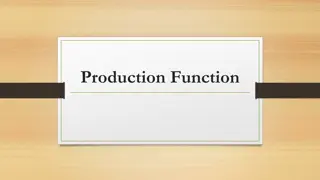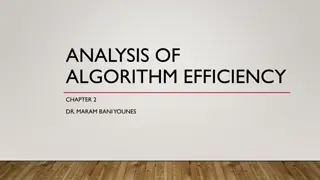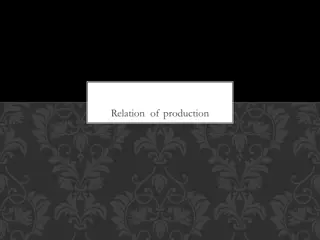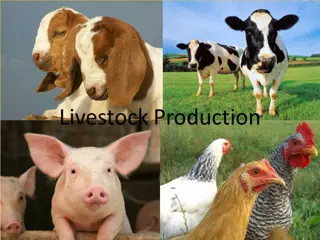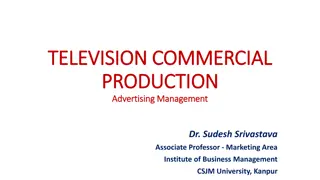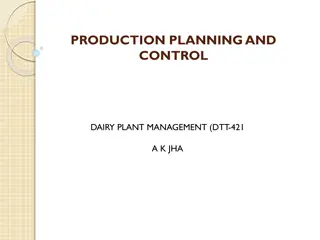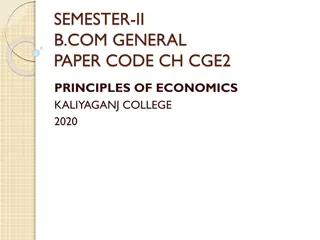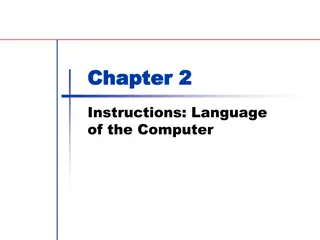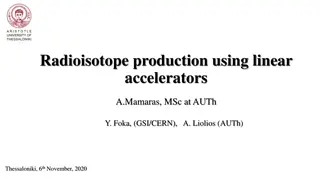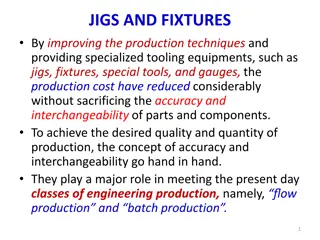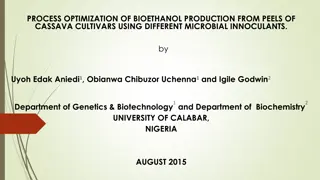Focus on Efficiency and Effectiveness in Production Operations
Production operations emphasize efficiency and effectiveness through substantial measurement and analysis of internal processes. This involves various strategies such as Material Requirements Planning (MRP), Enterprise Resource Planning (ERP), Lean Manufacturing, and more. Management commitment plays a crucial role in ensuring continuous improvement, utilization of the entire workforce, and adherence to quality improvement processes.
Download Presentation

Please find below an Image/Link to download the presentation.
The content on the website is provided AS IS for your information and personal use only. It may not be sold, licensed, or shared on other websites without obtaining consent from the author.If you encounter any issues during the download, it is possible that the publisher has removed the file from their server.
You are allowed to download the files provided on this website for personal or commercial use, subject to the condition that they are used lawfully. All files are the property of their respective owners.
The content on the website is provided AS IS for your information and personal use only. It may not be sold, licensed, or shared on other websites without obtaining consent from the author.
E N D
Presentation Transcript
IENG 366 Managing Production Operations Reading: pp. 279 299.
Major focus of production operations is on efficiency and effectiveness of processes Production operations often include substantial measurement and analysis of internal processes PRODUCTION OPERATIONS
Material Requirements Planning (MRP) Manufacturing Resource Planning (MRP II) Enterprise Resource Planning (ERP) Synchronized Manufacturing (OPT) Lean Manufacturing (TPS) Production Planning and Control Systems
Figure 11-8 Schedule of production lead times for product A.
Figure 11-9 Examples of kanban cards. (From Hussein M. Reda, A Review of Kanbanthe Japanese Just-in- Time Production System, Engineering Management International, 4, 1987, p. 146).
Figure 11-10 Mechanics of a simple kanban cycle. (1) Part produced at preceding station and P- kanban attached to it is sent to the store. (2) When the part is needed at a succeeding station, a W- kanban is sent to the store to withdraw the part. (3) At the store, the P-kanban is removed from the part and the W-kanban attached to it. The P-kanban is then collected in a production-ordering box. (4) At short time intervals, the P-kanban is then sent to the preceding station, constituting a production order. (5) The part with the W-kanban goes to the succeeding station to meet the demand. (6) The W- kanban is detached from the part and collected in a withdrawal box. (From Hussein M. Reda, A Review of Kanban the Japanese Just-in-Time Production System, Engineering Management International, 4, 1987, p. 146).
Management commitment Focus on customer Internal or external Any person receiving the output Continuous improvement of processes Utilization of entire work force Performance measures for the processes Use of a rational, verifiable, improvement process: Define Measure Analyze Improve Control Basic Requirements of Quality Improvement
Three Aspects: Location Spread Shape Variability is inherent in all processes. SPC helps to: Quantify Communicate Make Decisions Quality: Understanding Process Variation
Total Cost Failure Cost $ Quality Cost Defect Rate Quality Myth: Higher Quality Higher Cost
Very Often: Higher Quality Lower Cost Textbook ex: Manufacture of Copier Part 100 parts 75% Conform (75 good parts) Manufacturing Process $20 / part (10 scrap parts) 25% Non-conforming: (25 parts) (15 good parts) Re-work Process $4 / part
Study finds excessive process variability responsible for high nonconformity rate New SQC procedure implemented NOW: manufacturing non-conformities = 5% SAVINGS: $22.89 $20.53 = $2.36 / good part PRODUCTIVITY: 9% improvement
7 Tools of Ishikawa Histogram Pareto Chart Fishbone Chart (Cause & Effect Diagram) Check Sheet Defect Concentration Diagram Scatter (Plot) Diagram Statistical Process Control Charts Variables Charts Attributes Charts Individuals Charts Short Run SPC Process Capability Measures MIL STD 105D & Other Sampling Plans Designed Experiments Quality Control Tools and Techniques
Histogram 25 2019 20 16 Frequency 15 13 1211 10 4 5 2 1 1 0 0 0 0 0 0 0 0 0 0 0 511 512 513 514 515 516 517 518 519 520 Bin 521 522 523 524 525 526 527 528 529 530 Ishikawa s Tools: Histogram
80% of any problem is the result of 20% of the potential causes Histogram categories are sorted by the magnitude of the bar A line graph is overlaid, and depicts the cumulative proportion of defects Quickly identifies where to focus efforts Pareto Chart for Paint Defects 120 120% 100% 100 80 80% Cumulative % Frequency 60% 60 40 40% 20% 20 0 0% Off-Color Thin Coat Thick Coat Tacky Abrasion Dirt/Dust Blisters Wrong Color Defect Type Ishikawa s Tools: Pareto Chart
Man Method Skill Level Low RPM Attention Level Travel Limits Dusty Bad Paint Environment Poor Conductor Temperature Humidity Poor Mixing Orifice Clogs Poor Vendor Worn Parts Machine Material The purpose of the cause and effect diagram is to obtain as many potential influencers of a process, so that the problem solving can take a more directed approach. Ishikawa s Tools: Cause & Effect Diagram
A defect concentration diagram graphically records the frequency of a defect with respect to product location. Obtain a digital photo or multi-view part print showing all product faces. Operator tallies the number and location of defects as they occur on the diagram. Ishikawa s Tools: Defect Diagram
Title Header Info: Date, Time, Location, Operator, etc. Check sheets are used to collect data (values or pieces of information) in a consistent manner. List each of the known / possible problems Record each occurrence including time- orientation. Times of Problem Occurrence (periodic) List of Prob Types Statistics For Prob Types Raw Data recorded here Overall Statistics Time of Occurrence Statistics Instructions, settings, comments, etc. Ishikawa s Tools: Check Sheet
A scatter plot shows the relationship between any two variables of interest: Plot one variable along the X-axis and the other along the Y-axis Y Y Y X X X The presence of a relationship can be inferred or ruled out, but it cannot determine if a cause and effect relationship exists Ishikawa s Tools: Scatter Plot
2 UCL 0 CL 2 2 LCL 2 0 Sample Number 2-Sided Hypothesis Test Sideways Hypothesis Test Shewhart Control Chart A control chart is like a sideways hypothesis test Detects a shift in the process Heads-off costly errors by detecting trends Ishikawa s Tools: SPC Charts
Process Over Time Control Charts Process Doing OK Lower Upper Specification Limit Specification Limit X-bar R Mean shift in process X-bar R Increase in process variance X-bar R Why Monitor Both Process Mean and Process Variability? Ishikawa s Tools: SPC Charts
Statistical Quality Control and Improvement Removing special causes of variation Preparation for: hypothesis tests control charts process improvement Improving Process Capability and Performance Continually Improve the System Characterize Stable Process Capability Head Off Shifts in Location, Spread Time Identify Special Causes - Bad (Remove) Identify Special Causes - Good (Incorporate) Reduce Variability Center the Process LSL 0 USL Use of Ishikawa s Tools
Figure 12-3 Four distributions of a quality characteristic in terms of the upper and lower specification limits (USL and LSL) and specification midpoint m.
Variables Continuous measures L, W, H, Dia. Viscosity Temperature Variables Charts X-bar charts Location of dist. Center R- (or s-charts) Range (spread) of dist. Attributes Discrete measures Defectives (no value) Attributes Charts Variable / Fixed sample size Defectives p-, np-charts Defects (diminished value) Defects u-, c-charts Control Charts (HW 03)
Questions & Issues? IENG 366 Engineering Management



